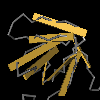?
 
Src homology 3 domain of Abl Interactor proteins Abl interactor (Abi) proteins are adaptor proteins serving as binding partners and substrates of Abl tyrosine kinases. They are involved in regulating actin cytoskeletal reorganization and play important roles in membrane-ruffling, endocytosis, cell motility, and cell migration. They localize to sites of actin polymerization in epithelial adherens junction and immune synapses, as well as to the leading edge of lamellipodia. Vertebrates contain two Abi proteins, Abi1 and Abi2. Abi1 displays a wide expression pattern while Abi2 is highly expressed in the eye and brain. Abi proteins contain a homeobox homology domain, a proline-rich region, and a SH3 domain. The SH3 domain of Abi binds to a PxxP motif in Abl. SH3 domains are protein interaction domains that bind to proline-rich ligands with moderate affinity and selectivity, preferentially to PxxP motifs. They play versatile and diverse roles in the cell including the regulation of enzymes, changing the subcellular localization of signaling pathway components, and mediating the formation of multiprotein complex assemblies. |
